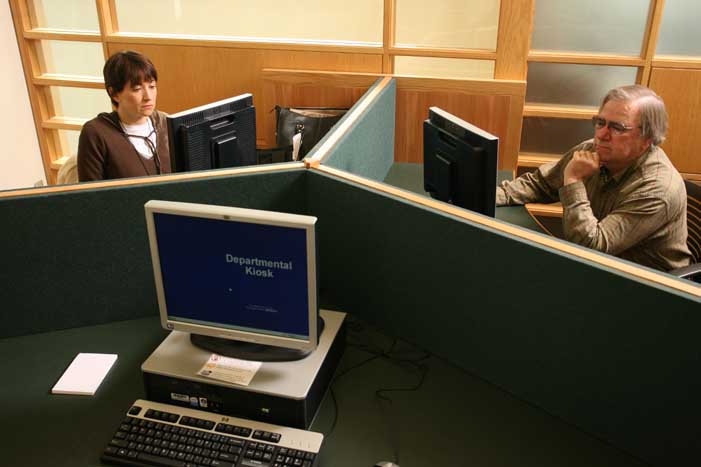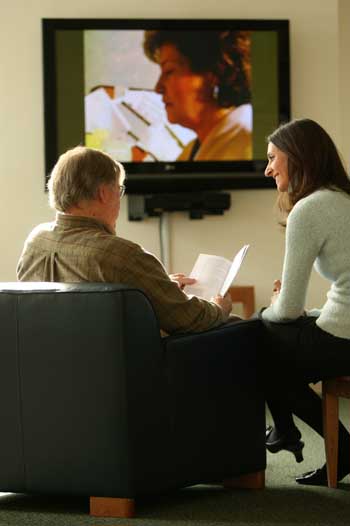 |
Archive for September, 2008
Friday, September 19th, 2008
Contributed by Cindy Stewart
The Heath Education Center at Dartmouth-Hitchcock Medical Center
In October 2007 the Health Education Center (HEC) at the Dartmouth-Hitchcock Medical Center (DHMC) in Lebanon, NH, was officially opened for business. The HEC serves DHMC patients, their family members, and the community at large.
The HEC is a collaborative effort among several departments: the Dartmouth College Biomedical Libraries, the Dartmouth College Center for Continuing Education in the Health Sciences, and the hospital’s Center for Shared Decision Making. The Center for Shared Decision Making helps individuals with difficult healthcare decisions. Shared Decision Making staff in the HEC offer helpful videos from their Decision Aid collection.
The HEC is focused on connecting the dots between information requirements, the need for emotional and educational support, and
on-site counseling for medical decision making. Biomedical Libraries staff, a health
educator, and Center for Shared Decision Making staff are available to assist users. A team of trained volunteers from the hospital’s Volunteer Services department also helps to make the HEC a friendly and welcoming environment.
Computers and Internet access are available 24/7 for individuals to check email, search the web for health information, and to work on a health status questionnaire. The health status questionnaire is required of many of the patients at DHMC. If they do not have a computer or Internet access at home, or if they are not comfortable using a computer, they can work with a HEC staff member or volunteer on their questionnaire. There is a quiet reading room, equipment for viewing video based decision aids and other health education material.
There is also a classroom for use by support groups and other health-related programs (including tobacco cessation, advance directives, and finding health information).
For more information about the Health Education Center, visit http://www.dhmc.org/goto/hec or contact Cindy Stewart, Associate Director, Dartmouth College Biomedical Libraries.
Posted in Chic Chat | Comments Off
Wednesday, September 17th, 2008
Hello everyone.
This note announces the availability of subcontract and awards funding from NER for 2008-2009. I’ve pasted information relevant to both subcontracts and awards below. Please contact Javier Crespo if you have any questions or want to talk about project possibilities you’ve been thinking about.
NER announces the availability of Health Information Outreach Subcontracts. Health Information Outreach Subcontracts assist Network members and other health-related agencies in their efforts to provide information services and training to audiences not normally reached. Target audiences can be health care workers, librarians and others who refer consumers to health information, and consumers.
Subcontracts fund extended health information projects that generally run from 12 to 18 months. The Health Information Outreach Subcontract’s primary aim is to broaden access to health information resources featuring National Library of Medicine resources.
Total amount to be funded for any or all approved projects is $40,000.
Proposals are due October 28, 2008.
Awardees will be contacted on or before November 30.
Funded projects can begin their performance period after January 1, 2009.
The complete Request for Proposal (RFP) is available at http://nnlm.gov/ner/funding/rfps/Health_Info_Outreach_Subcontract_y3.pdf
Proposals are accepted from Full or Affiliate members of the NN/LM NER. Partnerships with affiliate members, public health agencies, state, county and /or local public health agencies and community-based groups are strongly encouraged. Proposals are encouraged from community-based agencies and organizations working with providers and patients or other agencies seeking to conduct a health information project.
In addition funds are limited but available for the following awards:
Express Outreach and other awards
Community Engagement Awards support short-term outreach projects for advancing health information
Course Development Awards support the development of instructional programs
Exhibits Awards are for members’ participation at venues that promote health information resources.
Technology Awareness Program Awards fund learning programs for the application of technology in health information
Internet Connectivity Awards fund the expanded access to health information needed in libraries and other settings
There’s more information for both subcontracts and awards available at http://nnlm.gov/ner/funding/
Posted in Announcements | Comments Off
Tuesday, September 9th, 2008

As we are making plans to attend October’s NAHSL Conference (our 50 anniversary!) here are a couple of courses to be taught by NER and para-NNLM staff. Consider attending!
Your Library’s Value: Needs Assessment, Program Development, Program Evaluation-Cindy Olney
4 MLA CE Credits (pending)
Sunday Morning CE (8:00 am - 12:00 pm)
Course Description:
One goal of evaluation is to assess and improve the “value” of a program or unit. In this workshop, participants will first learn how to define “value” by assessing the needs of the many different stakeholders in their environment (users, administrators, library staff, etc.). They then will learn to map their programs and services against institutional goals using a logic model and develop an evaluation plan to investigate and document their libraries’ contributions to the institutional mission. The workshop will end with a presentation about online library-value calculators, which participants can use for cost-benefit analysis and return-on-investment.
Target Audience:
Health sciences librarians (although information will be applicable to other library settings) Difficulty Level:
Introductory
Class Objectives:
By the end of the class, participants will be able to translate larger institutional goals into library goals and outcomes, then develop a plan to provide and evaluate programs and services that will demonstrate their library’s value.
Instructor: Cindy Olney, PhD
Cynthia Olney is an evaluation specialist for the NN/LM Outreach Evaluation Resource Center, has provided consultation for numerous National Library of Medicine and other health information outreach projects, and will present this OERC workshop.
The Healthy Librarian - Michelle Eberle
2 MLA CE Credits
Tuesday CE (1:00 pm - 3:00 pm)
Course Description:
Learn simple strategies to cultivate wellness in the workplace at your library. Participants will learn skills to manage challenges of the job including emotional patrons and a sedentary job. This interactive session will explore practical solutions including stress management skills, ergonomics and how to incorporate more activity into your day.
Resources for improving one’s health literacy including health check tools and developing resiliency for changes in the profession will be explored. Participants will leave with enhanced knowledge and practical skills for incorporating healthy habits into their daily work.
Target Audience:
Anyone interested in managing stress, ergonomics and creating a healthier workplace Difficulty Level:
Beginning
Class Objectives:
Know why workplace wellness matters Learn the difference between workplace wellness and a health promoting work culture c. Gain valuable tools to enhance workplace wellness in the following areas: nutrition, ergonomics, stress management, exercise and fitness and beyond the workplace Leave feeling rejuvenated with creative ideas to make their library a health promoting workplace
Instructor:Michelle L. Eberle, MS LIS
Michelle Eberle, is the Consumer Health Information Coordinator (CHIC) for the National Network of Libraries of Medicine, New England Region. With a position with a really neat acronym, she travels around New England educating librarians, health professionals and consumers about National Library of Medicine resources and services.
Michelle earned a Masters in Library and Information Science from Simmons College in Boston, MA where she was blessed to meet her husband, Matt, also a medical librarian. Michelle graduated from Sacred Heart University in Fairfield, Connecticut with a Bachelors of Arts in Social Work. After graduating from Simmons, Michelle worked at the Somerville Hospital as a solo Medical Librarian. At Somerville Hospital, she discovered her passion for consumer health librarianship by serving on the patient education committee.
See the other education offerings to be offered at NAHSL ‘08 at: http://nahsl.org/2008/ce.html
Posted in Announcements | Comments Off
Tuesday, September 9th, 2008
The September issue of NIH News in Health, the monthly newsletter bringing you practical health news and tips based on the latest NIH research, is now online at http://newsinhealth.nih.gov/. In this issue of NIH News in Health:
Good Health to Go
Eating Smart at School
Even in the chaotic world of the school cafeteria, children can make smart food choices. You can play a key role in helping children learn the fundamentals of healthy living—eating well and staying active—whatever pressures they face outside home.
full story
Back to School with Diabetes
Plan Ahead for a Smooth Start to School
Notebooks, erasers, pencil sets and backpacks are on most kids’ back-to-school lists. But if your child has diabetes, you should add a few extra tasks to the list. Planning ahead, and getting help from others, will help pave the way for a successful year.
full story
Click here to download a PDF version for printing.
Subscribe to receive email alerts when new issues of NIH News in Health are posted by going to https://list.nih.gov/cgi-bin/wa?SUBED1=nihnewsinhealth-l&A=1.
Please pass the word on to your colleagues about The NIH News in Health. We are happy to send a limited number of print copies free of charge for display in offices, libraries or clinics. Just contact us for more information.
If you’re an editor who wishes to reprint our stories, please see http://newsinhealth.nih.gov/about.htm for information.
Sincerely,
Harrison Wein
Harrison Wein, Ph.D., Writer/Editor
National Institutes of Health
Office of the Director, Office of Communications and Public Liaison
Bldg. 31, Rm. 5B64A, MSC 2094
Bethesda, MD 20892-2094
Phone: 301-435-7489
Fax: 301-480-4026
E-mail: weinh@od.nih.gov
Posted in Announcements | Comments Off
Monday, September 8th, 2008

In the field of computer networking, the term “load balancing” often refers to a technique usually performed by software to spread work evenly among computer processors. In the world of interlibrary loan (ILL), load balancing has come to mean “the process by which a load of borrow requests is spread among viable lenders.”
No attempt to apply load balancing may be found in DOCLINE, yet many participants think that it exists. Why is that?
Perhaps a stroll down memory lane — or regional library history — is in order:
In June 1986, a health sciences library consortium emerged, the Basic Health Sciences Library Network (BHSL, pronounced “bissel”), to promote free reciprocal lending among its members. This consortium grew rapidly to include members from the northeastern corridor (that is, states that make up today’s Middle Atlantic and New England Regions). The group established a hierarchical structure of 8 levels to address calls for parity and fairness in lending which, in turn, resulted with an improvised system of load balancing: BHSL Coordinators in each state assigned levels to individual members based on their ILL statistics for the preceding 12 months. Members then engaged in lending to other members within their level or below. Levels were also displayed with an asterisk and a number following the Institution Name in the member’s DOCLINE Institution Record. By all accounts, this load balancing system worked reasonably well.
All that changed, however, in February, 2007, with the release of DOCLINE® 2.7 and NLM’s introduction of new functionality that allowed the entry of library groups directly into the DOCLINE Routing Table. On the one hand, the enhancement was hailed as a positive development, one that promised less routine table maintenance for system participants. On the other hand, introduction of the revised software resulted in the consequential removal of BHSL’s level hierarchy – along with their improvised system of load balancing. Today, BHSL remains a sizeable library group within DOCLINE of close to 400 members, eclipsed in size only by FreeShare (the Free Reciprocal Interlibrary Loan Group), which has a membership of close to 1,500 members!
So for the record: load balancing never was a feature of DOCLINE, either before or after the removal of the BHSL hierarchy. Granted, load balancing remains fresh in the minds of many BHSL participants that became accustomed with the concept, but it is the ghost image of a BHSL practice long gone … for better or for worse.
Now some folks may be wondering: if functionally DOCLINE doesn’t use load balancing, what is at play with routing requests? In a word: randomization.
The routing algorithms of DOCLINE are predicated on the science of randomization. Randomization may be defined as …“a deliberately haphazard arrangement so as to simulate chance”. When a borrow request works its way through the DOCLINE system, an internal algorithm checks for potential lenders that meet certain criteria, as defined in the Boolean string:
((PREFERRED DELIVERY METHOD AND (TITLE+VOLUME) OR (TITLE+YEAR))
Twenty “potential lenders” are then placed into a “pool” for one-by-one selection. A “match” program randomly selects a potential lender from the available pool and routes the borrow request. If the lender either: (a.) fails to “receipt” the request within 24 hours; or (b.) is unable to fill the request within 72 hours, the request is then re-routed to the next potential lender from the amassed pool of potential lenders. The same logic is employed for routing within library groups.
To be sure, there will be times when a borrower thinks they see an emerging pattern. Or maybe they begin to think something has gone horribly wrong with the system. Or maybe they’ll stop and wonder: “how come we end up with all these requests from the same library, without even a ‘prefix’?” But don’t get fooled! – it all comes back to chance and randomization. For the universe as well as DOCLINE.
Posted in ILLAdvised | Comments Off
|
 |







